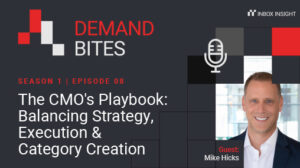Winning over B2B buyers is tough, which is why businesses are constantly seeking new ways to engage their target accounts and stand out in this competitive environment.
One of the most effective ways they can do this is personalization through account-based marketing (ABM).
Unlike traditional marketing methods that cast a wider net, ABM campaigns allow businesses to concentrate their efforts on the accounts that matter most; those that are most likely to drive revenue growth.
But in order to give them the best chance of generating leads and driving sales, these campaigns must be personalized. Taking this strategic approach can be hugely successful and 93% of companies say they have already experienced a lift in conversion rates as a result.
This is because ABM focuses on targeting high-value accounts with content, messaging, and interactions that are tailored to their specific needs and preferences. It is this level of personalization that helps your business to demonstrate a deep and meaningful understanding of your audience and to establish stronger connections with them.
Keeping that in mind, we’re going to take a more in-depth look at ABM and how you can harness the power of personalization through your marketing strategy.
What does personalization mean in ABM?
Unlike traditional marketing which targets a much wider audience and takes a one-size-fits-all approach, account-based marketing (ABM) offers personalized messages for individual companies or accounts.
This technique focuses on delivering personalized content to key decision-makers within your target accounts, treating each account as a distinct market of one.
To make this possible, marketers must understand the specific needs, challenges, and pain points of the key stakeholders within an account, and then craft personalized messaging, content, and experiences that resonate with them on a deeper level.
It is these tailored experiences that help to cut through the noise and capture the attention of the right people at the right time.
Ultimately, this can help to drive better engagement, build stronger relationships, and increase the likelihood of closing deals with high-value accounts. However, it’s important to note that personalization in ABM goes far beyond simply inserting a prospect’s name into an email or targeted advert.
It involves truly understanding the account’s business, industry, and the unique challenges they face. This requires you to gather detailed data and insights about each account, its decision-makers, and their specific roles and responsibilities within the organization.
Why is personalization crucial in Account-Based Marketing?
Personalization is crucial in account-based marketing for several reasons. First and foremost, it allows businesses to tailor their messaging and content to specific accounts, as well as the individuals within those accounts.
Generic, one-size-fits-all marketing campaigns often fall flat and fail to capture the attention of busy decision-makers. But through personalization, you can nurture customer relationships, and almost 85% of marketers say this personal approach significantly helps to build strong relationships.
Building trust and credibility
Secondly, by consistently delivering relevant and personalized content, businesses can build trust, credibility, and loyalty over time, which can lead to increased customer retention and advocacy.
If you operate in a competitive field, personalization can be a significant differentiator. When prospects and customers feel that a business truly understands their needs and provides tailored solutions, they are more likely to choose that business over their competitors.
Plus, in the B2B space, decision-making processes are often more complex and involve multiple stakeholders. Because different departments and roles have different business problems, marketers can tailor messaging to appeal to each player’s individual needs.
That way, you can demonstrate a deep understanding of their specific needs and position your business as a valuable partner, rather than just another vendor vying for attention.
Improving marketing efficiency
Lastly, personalization allows businesses to optimize their marketing efforts and resources, leading to improved marketing efficiency and better return on investment (ROI).
By focusing on the accounts that matter the most, businesses can allocate their budgets and efforts more effectively, resulting in higher ROI and better overall performance. In fact, according to our first-party research, 66% of B2B marketers say that ABM delivers a higher ROI than many other techniques they use, such as inbound marketing.
Who should use personalized ABM?
Before we determine who should use personalization within their marketing strategy, it’s worth saying that an effective ABM strategy can benefit businesses of all shapes, sizes, and across various industries.
However, there are some that will derive more success from this strategy and these might include:
More complex industries and services
Although every industry can benefit from this strategy, B2B companies operating in industries such as technology, manufacturing, healthcare, financial services, and professional services can significantly benefit from personalized ABM.
These industries often involve intricate buying processes, multiple stakeholders, and unique pain points that require more customized solutions.
This is particularly true for those who sell complex, high-value products or services that require a more consultative sales approach.
Those with a well-defined ICP
Businesses with a well-defined ideal customer profile (ICP) and target account list will not only find ABM more beneficial, but they’ll also find it easier to implement these campaigns in the first place.
Especially those companies targeting specific high-value accounts, such as large corporations or government organizations. By tailoring their messaging and content to the unique needs and challenges of these accounts, businesses can increase their chances of winning and retaining these lucrative opportunities.
Not only this but companies with a longer sales cycle, multiple decision-makers involved, and a need for tailored messaging are prime candidates for leveraging personalized ABM strategies.
Larger enterprises
Lastly, larger enterprises with substantial marketing budgets and resources are also well-positioned to implement comprehensive personalized ABM campaigns.
That being said, small and medium-sized businesses (SMBs) can still leverage personalized ABM tactics on a smaller scale to target their most valuable accounts more effectively.
Steps to implement personalization in ABM
With one in three marketers ready to implement this personalization strategy in the near future, many are curious about where to start. In this next section, we’ll break down the process into four simple steps.
1. Determining important data for individual accounts
The first step in implementing personalization in ABM is to gather and analyze relevant data about your target accounts. This includes firmographic data like company size, industry, and location, as well as technographic data around the tools and technologies used. Intent data can be extremely helpful at this stage.
You’ll also want to gather insights into the pain points, challenges, and goals of each specific account. This data will inform your personalization strategy and help you tailor your messaging and content accordingly.
2. Choosing target accounts
Based on the data gathered, you’ll need to identify and prioritize your target accounts. This process may involve segmenting accounts based on factors like industry, revenue potential, likelihood to buy, strategic fit, or geographic location.
Tools like a CRM system can help to divide your ideal customer profiles (ICPs) into tiers — for instance, tier 1, tier 2, and tier 3, allowing you to focus your personalization efforts on the most valuable accounts.
3. Developing ABM strategy
With your target accounts identified, you can develop a personalized, multi-channel ABM strategy for each one, taking their unique needs, buyer behaviors, and preferences into account.
This will involve creating account-specific content, tailoring your messaging and value propositions, and mapping out personalized touchpoints across the different channels that will resonate with each account.
4. Measuring success
The final step is to evaluate the effectiveness of your personalization efforts. As part of this, it’s essential to establish key performance indicators (KPIs) and regularly track and measure them.
Relevant ABM metrics may include engagement rates, conversion rates, sales cycle length, and revenue generated from target accounts. You can continue to optimize your approach based on the results and insight gathered at this stage.
Benefits of personalization in ABM strategy
Personalizing your account-based marketing efforts can deliver a wide range of benefits for your business, such as creating an effortless customer journey.
For example, 77% of B2B buyers revealed that their latest purchase was very complex. This gives more power to these personalized experiences as they can improve and support the buying process for a more seamless and enjoyable customer experience.
Some of the key benefits of utilizing personalization in ABM include:
- Improved engagement and conversion rates: Personalized marketing efforts are more likely to resonate with the target audience, leading to higher conversion rates. In fact, 83% of marketers say personalization in ABM increases engagement with target accounts
- Better ROI: Personalization can help companies get the most out of their marketing investments by targeting the right accounts and delivering the right messages at the right time
- Stronger customer relationships: By providing tailored and relevant experiences, businesses can foster stronger connections with their target accounts, leading to increased trust and loyalty, with 85% of marketers saying ABM is crucial for retaining and expanding client relationships
- Competitive advantage: In a crowded market, personalization can help businesses stand out and differentiate themselves from competitors
- Alignment between sales and marketing: Personalized ABM campaigns require close collaboration between sales and marketing teams, leading to better alignment and improved overall efficiency
- Optimized marketing spend: You can optimize your market spend by focusing your efforts on the highest-value accounts that are most likely to convert
What we’re trying to say here is that by leveraging data and insights about target accounts, businesses can craft compelling personalized experiences that cut through the noise and foster stronger connections – driving better results across the entire funnel.
Impact of personalization on ABM strategy
Personalization is a critical component of an effective account-based marketing (ABM) strategy, and it can significantly impact and improve overall ABM performance. But don’t just take our word for it, let’s take a look at the facts.
Personalization leads to revenue growth
Personalization is also key for aligning sales and marketing teams, and organizations with aligned sales and marketing teams see an average of 32% annual revenue growth, while less aligned companies could see a 7% decline in growth.
On top of this, personalized ABM campaigns are more likely to resonate with the target audience, leading to higher conversion rates and more qualified leads. When prospects feel that the content and messaging are directly relevant to their unique situations, they are more inclined to engage and progress through the sales funnel.
This personalized approach not only improves lead quality but also helps to accelerate the sales cycle, as prospects are better nurtured and more prepared for meaningful conversations with sales teams. This can lead to a 30% reduction in ‘time to opportunity’ after implementing ABM strategies, as well as a reduced ‘opportunity to close’ time by a month and a correlated 8-10% increase in revenue.
It also increases lifetime value and retention rates
Personalization in ABM strategies fosters stronger relationships with key accounts. By demonstrating a deeper understanding of their business, challenges, and goals, organizations can increase customer loyalty and lifetime value.
It also plays a crucial role in account expansion and retention efforts within an ABM strategy. By continuously delivering personalized content and experiences tailored to the evolving needs of existing customers, organizations can identify new opportunities for upselling and cross-selling, and reduce the risk of customer churn.
Overall, the impact of personalization on your ABM strategy is significant, driving improved engagement, conversion rates, collaboration, customer relationships, and ultimately, revenue growth. As organizations continue to refine their personalization capabilities, they can expect to see even greater returns from their ABM investments.
Top personalization tactics in ABM
There are various tactics that businesses can employ to personalize their ABM efforts across different channels and touchpoints to create a cohesive and tailored experience for target accounts. Here are some of the most effective ones for you to consider:
1. Website personalization
Your website is often the first touchpoint for prospects, so personalizing it based on account data can make a powerful first impression.
This can be achieved through thorough research, data analysis, and close collaboration between marketing and sales teams. Once you have a comprehensive understanding of the account, you can create personalized website experiences that speak directly to their pain points, showcase relevant solutions, and guide them through a tailored journey.
This can be done by dynamically adjusting website content and messaging, showcasing relevant products, case studies, and calls-to-action based on the visitor’s account information.
Some common techniques for website personalization in ABM include:
- Dynamic content swapping: Replacing generic website content with account-specific messaging, case studies, or product information based on the visitor’s account
- Personalized calls-to-action (CTAs): Presenting tailored CTAs that align with the account’s current stage in the buyer’s journey or specific use case
- Account-based landing pages: Creating dedicated landing pages for high-value accounts, featuring customized content, messaging, and offers
- Personalized navigation and user flow: Adjusting the website’s navigation structure, layout, and user flows based on the account’s specific interests or product needs
- Account-based retargeting: Serving targeted ads and messaging to specific accounts as they browse the web, reinforcing your brand and value proposition
By delivering a personalized website experience, businesses can significantly enhance engagement, build stronger connections with target accounts, and ultimately drive better conversion rates and sales opportunities within their ABM strategy.
2. Personalized sales outreach
Marketing can also empower the sales team with deep account insights that enable them to personalize their own outreach.
Providing tailored messaging, content recommendations, and talking points specific to each prospect’s role, business challenges, and buying journey stage can support sales.
This is crucial as only 38% of salespeople are sending personalized communications to top prospects on every single touchpoint, highlighting the need for improvement in this area.
3. Social media ads personalization
Another great tactic is leveraging the targeting capabilities of social media platforms as a way of serving personalized ads to specific accounts and key decision-makers. You can use account intelligence for personalized ABM campaigns, crafting compelling ad copy and content that resonates with each target account.
By using account-level data, businesses can create highly targeted ads that speak directly to the interests and pain points of their target audience. Interestingly, 84% of C-level and VP-level buyers say they are influenced by social media, making this a valuable channel for personalization.
4. Email campaign personalization
Personalized email campaigns can be highly effective in nurturing target accounts through the sales funnel with open rates increasing by 53% when compared to generic email copy.
In order to get the best results, you need to segment your email campaigns based on account data to deliver highly relevant content and messaging.
This will enable you to tailor the subject lines, content, and calls-to-action based on the recipient’s account information, role, and what stage they are at in the buyer’s journey.
Conversational ABM as a solution for personalization at scale
Conversational ABM is another strategy that is gaining traction as a powerful approach to delivering personalized experiences at scale within account-based marketing.
These solutions leverage artificial intelligence (AI) and machine learning to analyze account data and deliver personalized, real-time conversations across various channels, such as chatbots, email, and social media.
Implementing conversational ABM in this way can help you deliver personalized experiences at scale and create a seamless, account-specific experience that resonates with your target accounts and drives better engagement and conversions.
On top of this, it allows for highly contextualized and real-time personalization of conversations based on the specific account’s attributes, behaviors, and needs. Conversational AI can dynamically tailor messaging, content recommendations, and next-best-actions for each unique account profile.
This level of granular personalization would be extremely difficult and costly to achieve through traditional marketing tactics. What’s more, as conversational AI continues to advance with natural language understanding and generation capabilities, it is always unlocking new opportunities for ABM personalization that simply weren’t feasible before.
As a result, businesses can now deliver individualized conversations across digital touchpoints at an unprecedented scale.
Ultimately, conversational ABM bridges the gap between the personalization needs of ABM and the scalability requirements of modern B2B marketing and sales motions. It’s an innovative solution that enhances both the customer experience and operational efficiencies for companies leveraging an account-based approach.
The future of personalization in ABM
The future of personalization in account-based marketing looks incredibly promising with the ABM market expected to surpass $1.6 billion by 2027.
As technology continues to evolve and customer expectations for personalized experiences increase, the role of personalization in ABM will only become more crucial.
What’s more, as data analytics capabilities continue to advance, marketers will have more robust tools to gather insights and better understand their target accounts. This will allow for even more precise personalization at scale.
AI and machine learning will be critical
Artificial intelligence and machine learning will play a huge role in this, automating many processes of data collection, analysis, and content personalization. AI can help identify the most effective messaging and content for each account based on their data profiles.
Plus, conversational AI assistants will become indispensable for delivering real-time, hyper-personalized conversations at every touchpoint.
Businesses that embrace personalization and leverage the power of data, AI, and automation will be better positioned to deliver exceptional customer experiences and drive better results from their ABM efforts.
Consumer expectations will continue to grow
As consumers’ expectations around personalization continue rising, B2B companies will be pressed to deliver more contextual, individualized experiences. Personalized ABM strategies integrating online and offline channels, from websites to sales outreach to direct mail, will be table stakes.
There will also likely be a continued blurring between ABM and the wider account-based experience (ABX) trend of personalizing every interaction throughout the entire customer lifecycle, not just marketing and sales. Personalization will extend into customer onboarding, support, cross-selling/upselling, retention efforts, and more.
Ultimately, the most visionary organizations will use personalization to transform their ABM strategy from outbound marketing to an immersive, bi-directional experience tailored to each account’s needs and preferences. The future is ripe for companies willing to embrace the power of data and personalization.
Businesses must prioritize data security
However, it’s important to strike a careful balance between personalization and privacy. As businesses gather and utilize more data for personalization purposes, they must also prioritize data security and transparency, ensuring they adhere to relevant regulations and maintain customer trust.
In conclusion, personalization is a key component of successful account-based marketing strategies. By tailoring your messaging, content, and overall approach to the specific needs and interests of each target account, businesses can improve engagement, conversion rates, and drive better ROI from their marketing efforts.
Does this sound like the best solution for your B2B marketing strategy?
If you’re in need of account-based marketing services, to support your strategy and help you deploy personalized, multi-channel digital campaigns, Inbox Insight can help.
We offer detailed analytics, precision targeting, and an immersive environment that enables you to identify and target high-potential accounts and generate leads.






